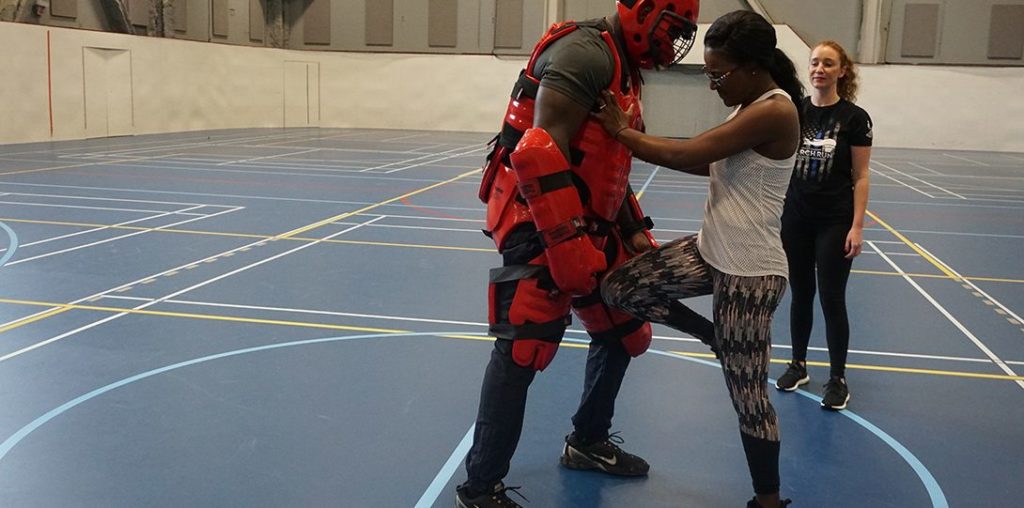Modern self-defense training is big business. Instructors can teach children, teens, single moms, adults of all ages and anyone else who wants to learn how to protect themselves. Self-defense trainers at the top of their game may work with professional athletes and celebrities who may not always have bodyguards by their side.

Self-defense instructors often have a background in martial arts, military service or law enforcement. Becoming an entrepreneur is one motion for pursuing a career as a self-defense instructor, although in practical terms these professionals also make significantly more money than a patrol cop or enlisted military personnel. It’s not uncommon for expert self-defense trainers to charge $200 or more per hour for one-on-one instruction.
As a bonus, when you become a self-defense instructor you’ll enjoy the professional satisfaction of helping people learn how to protect themselves in potentially life-threatening situations while getting into peak physical condition. To be a great instructor, you’ll need to stay in terrific physical shape yourself – another benefit. Ready? Read on to find out how you can pursue a rewarding career as a self-defense instructor.
In this article you’ll learn:
- How much money you can make as a self-defense instructor
- The required training and certifications
- Professional groups to join
- Employment opportunities for self-defense instructors
- Finding clients
- Plus helpful tips
How much money can you make?
Self-defense instructors working in the United States average $83,263 per year, according to a recent ZipRecruiter survey of professionals in the field. Entry level jobs started at $21,000 annually while pros in the top 10 percent of the profession were making $131,000 a year or more. If you work independently, you can base your pricing on group and private lessons, which are typically twice as expensive as group classes.

Training and Certification
Aside from a license to run a business, which all states require, you do not need a formal license to offer self-defense training. However, to get a job as a self-defense instructor, or launch a business that offers this training, you’ll need to become certified.
There are dozens of training and certification programs to prepare self-defense instructors. You can pursue coursework online, in-person or a combination of the two. As with any other educational offerings, self-defense instructor programs vary widely in cost and quality. Some are even free. You just take an exam.
Before choosing a program, do your research. You’ll want to choose the right program depending on what your goals are following your certification. Don’t be afraid to contact any training program and ask questions.
If you’re seriously considering a career as a self-defense instructor, then you probably already have experience in fighting styles, one or more martial arts, or combat techniques taught in the military and law enforcement. So, when selecting a training program to become an instructor, one good approach would be to find a program focused on the strengths and background you already possess. For example, if you are experienced in Jiu Jitsu, a self-defense instructor training program focused on Jiu Jitsu techniques might be your best option. First concentrate on training that builds upon what you’ve already learned, then you can decide whether to pursue training in additional combat/defense techniques as you expand your business.
Another strategy is to do some research on the self-defense training programs available where you live. If you can offer something desirable and different, and train as an instructor in that technique, you’ll have less competition when you launch your business.
Here are a dozen self-defense training programs you can research to get started.
Professional Groups to Join
When you become affiliated with a professional group, you show students and potential employers that you are dedicated to your work as a self-defense instructor. You’re telling other people that this is not just a job but a calling. These memberships look great on a resume when you’re job hunting. Benefits range from networking with other pros in your field to ongoing education and training, news about the profession and the sense of comradery that comes with belonging to a group whose members share your passion. Here are a few of the leading professional groups for self-defense instructors:

World Organization of Self Defence promotes national and international cross-training in all types of self-defense. The organization sponsors frequent events and training seminars. To join, you must request the form and fees by writing to wosdheadoffice@gmail.com.
American Women’s Self Defense Association is an educational, non-profit organization dedicated to ending violence against women by providing training programs to self-defense instructors, as well as services for women to increase their knowledge of self-defense techniques and rape prevention. Membership is $45 per year.
Here’s a list of nearly 100 self-defense instructor groups you can look through as you consider which ones to join.
Employment
Look for self-defense instructor jobs at the YMCA, public recreation centers, martial arts studios, and larger gyms with fitness programs. If you’re willing to relocate, set up search notifications on employment sites like Indeed.com to receive a daily email about job openings throughout the country or within the geographic areas you specify.

Once you’re established and have some experience, consider approaching security companies, law enforcement agencies and night watch services. You may be able to offer specialty training or continuing training with group classes for these organizations.
You’ll want to prepare your resume, both printed copies and a digital version for online distribution. When sending resumes by email, the best way to attach this document and supporting materials is by creating .pdf files of the documents with Adobe Acrobat. These types of files are considered safe to send and are less likely to trigger a spam alert in the recipient’s mailbox. Follow this tip and you’ll have a much better chance that your online correspondence lands in front of a real person, not a spam folder.
Also make photocopies of your professional certifications and memberships in self-defense organizations and clubs. These extra materials can pull your application to the top of the pile and set you apart from competitors for the same job.
Finding Clients
Business cards and a basic website should be the core of your marketing toolkit as a self-defense instructor. The website can be as fancy as you like, so long as it is attractively designed, with photos of your studio, students practicing their moves and a few images of you in action, teaching students. Your business location and contact information should be clearly visible at the top of every page on your website. Search engines scan this information to match your website geographically with people searching for a self-defense instructor.

In addition to your business website, the next thing to do is create an Instagram account to showcase your self-defense studio. Instagram is the #1 online venue for professionals to promote their work. It’s a free marketing tool that’s always working on your behalf.
Now set up a Facebook page for your self-defense school. This is a great way to build a following and keep people up-to-date on your offerings.
Be sure to create a Google My Business page, where you can add hours of operation, photos and an interactive map of your location.
All of the above services are free and setting up a page on each site takes less than an hour.
Other strategies for attracting new business:
- Create a referral program with discounts for students who bring new people to class.
- Ask students to review your self-defense training online. According to a recent survey, 90% of people say their buying decisions are influenced by positive online reviews.
Good to know
Self-defense instructors with years of experience say one of the most important things beginning instructors can do with each new class is to put the participants at ease. Students may feel nervous, unsure of themselves. In the back of their mind they are thinking that what they learn in your class could one day save their life, yet that thought triggers the realization they could one day face a life-threatening situation. Here are some basic safety tips you can share with students at the start of each new class before getting into the physical and psychological techniques of self-defense:
Know your surroundings
Be aware of your surroundings and any individuals in the vicinity whenever you are outside.
Don’t get distracted
Walking alone at night to your car is not the time to take out your phone and start a conversation, send a text or go web surfing. People with harmful intent are on the lookout for individuals who are preoccupied.

Say something if you’re uncomfortable
If someone gets too close to your personal space, speak up – loudly if you feel threatened.
Use whatever weapons you have at hand.
Carry car keys while walking to your vehicle. Don’t wait until you’re at the driver’s side door to start fishing around for keys in your pocket or purse. If attacked, keys can be a potent stabbing weapon. Aim for the attacker’s eyes, throat and crotch. If you’ve got an umbrella, jab an assailant with the pointed end. Pencils and pens also make improvisational stabbing weapons.
Don’t show fear
Project confidence through your body language. Walk at a deliberate, purposeful pace with your shoulders back. Make eye contact with anyone looking in your direction. This lets them know you are aware of their presence and are prepared.
Outdoor safety
If you exercise or run/jog while listening to music, keep the volume low enough so you can still hear the outside world. Also, look over your shoulder occasionally.
Trust your gut
Instincts are a powerful survival tool. If you feel threatened, chances are you are in danger.
Use your surroundings to your advantage
Maintain your personal space, but if someone gets too close, look for a way to increase the distance or put objects between you and the other person. As long as the person is unarmed, if he can’t reach you he can’t hurt you.
If you enjoyed this article, check out some more great PocketSuite.io content that can help you grow your career as a self-defense instructor. Here’s a great place to start.PocketSuite has thousands of business owners who all started where you are right now. Our community is always happy to help you ramp up, grow your client base, and achieve your income goals, both within the PocketSuite app and as part of our exclusive Facebook Community Group. PocketSuite’s vision is for any professional to be able to work for themselves and make a great living. It starts here. It starts with you. It starts today. Let’s get started, download PocketSuite now! Feel free to reach out with any questions (we’d love to hear from you)! Text us @ (415) 841-2300.





